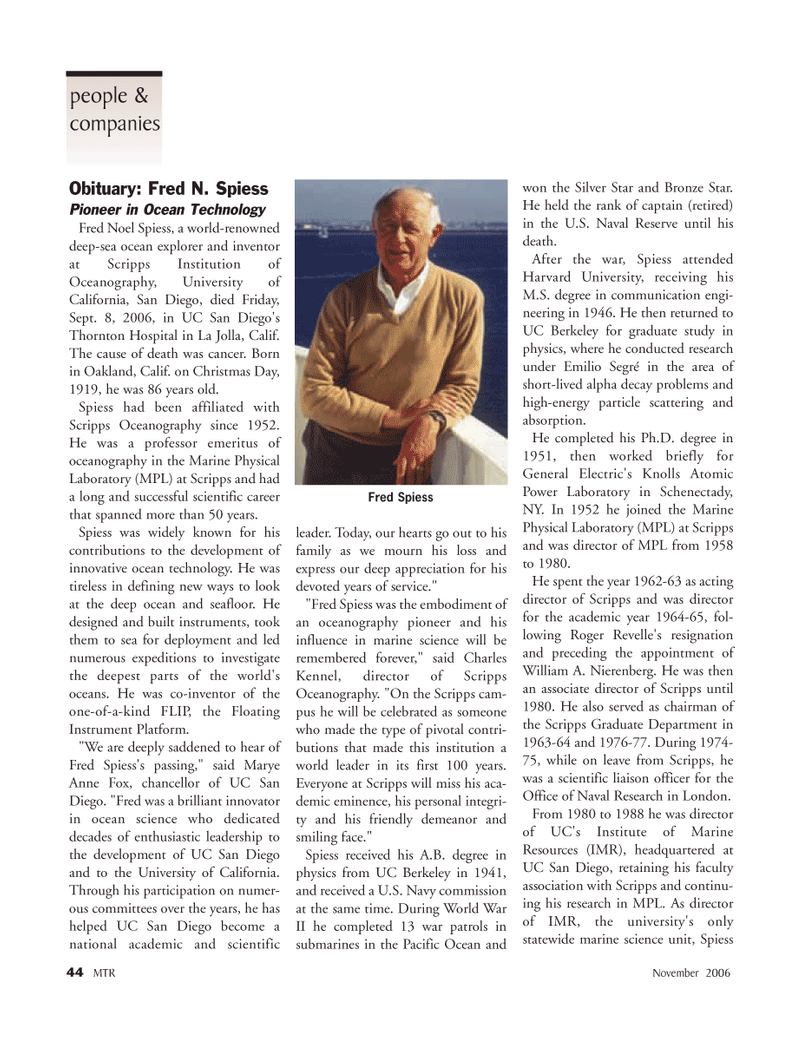
Page 44: of Marine Technology Magazine (November 2006)
Deep Ocean Exploration
Read this page in Pdf, Flash or Html5 edition of November 2006 Marine Technology Magazine
Obituary: Fred N. Spiess
Pioneer in Ocean Technology
Fred Noel Spiess, a world-renowned deep-sea ocean explorer and inventor at Scripps Institution of
Oceanography, University of
California, San Diego, died Friday,
Sept. 8, 2006, in UC San Diego's
Thornton Hospital in La Jolla, Calif.
The cause of death was cancer. Born in Oakland, Calif. on Christmas Day, 1919, he was 86 years old.
Spiess had been affiliated with
Scripps Oceanography since 1952.
He was a professor emeritus of oceanography in the Marine Physical
Laboratory (MPL) at Scripps and had a long and successful scientific career that spanned more than 50 years.
Spiess was widely known for his contributions to the development of innovative ocean technology. He was tireless in defining new ways to look at the deep ocean and seafloor. He designed and built instruments, took them to sea for deployment and led numerous expeditions to investigate the deepest parts of the world's oceans. He was co-inventor of the one-of-a-kind FLIP, the Floating
Instrument Platform. "We are deeply saddened to hear of
Fred Spiess's passing," said Marye
Anne Fox, chancellor of UC San
Diego. "Fred was a brilliant innovator in ocean science who dedicated decades of enthusiastic leadership to the development of UC San Diego and to the University of California.
Through his participation on numer- ous committees over the years, he has helped UC San Diego become a national academic and scientific leader. Today, our hearts go out to his family as we mourn his loss and express our deep appreciation for his devoted years of service." "Fred Spiess was the embodiment of an oceanography pioneer and his influence in marine science will be remembered forever," said Charles
Kennel, director of Scripps
Oceanography. "On the Scripps cam- pus he will be celebrated as someone who made the type of pivotal contri- butions that made this institution a world leader in its first 100 years.
Everyone at Scripps will miss his aca- demic eminence, his personal integri- ty and his friendly demeanor and smiling face."
Spiess received his A.B. degree in physics from UC Berkeley in 1941, and received a U.S. Navy commission at the same time. During World War
II he completed 13 war patrols in submarines in the Pacific Ocean and won the Silver Star and Bronze Star.
He held the rank of captain (retired) in the U.S. Naval Reserve until his death.
After the war, Spiess attended
Harvard University, receiving his
M.S. degree in communication engi- neering in 1946. He then returned to
UC Berkeley for graduate study in physics, where he conducted research under Emilio Segré in the area of short-lived alpha decay problems and high-energy particle scattering and absorption.
He completed his Ph.D. degree in 1951, then worked briefly for
General Electric's Knolls Atomic
Power Laboratory in Schenectady,
NY. In 1952 he joined the Marine
Physical Laboratory (MPL) at Scripps and was director of MPL from 1958 to 1980.
He spent the year 1962-63 as acting director of Scripps and was director for the academic year 1964-65, fol- lowing Roger Revelle's resignation and preceding the appointment of
William A. Nierenberg. He was then an associate director of Scripps until 1980. He also served as chairman of the Scripps Graduate Department in 1963-64 and 1976-77. During 1974- 75, while on leave from Scripps, he was a scientific liaison officer for the
Office of Naval Research in London.
From 1980 to 1988 he was director of UC's Institute of Marine
Resources (IMR), headquartered at
UC San Diego, retaining his faculty association with Scripps and continu- ing his research in MPL. As director of IMR, the university's only statewide marine science unit, Spiess people & companies 44 MTR November 2006
Fred Spiess
MTR#9 (33-48).qxd 11/13/2006 4:38 PM Page 44

 43
43

 45
45
